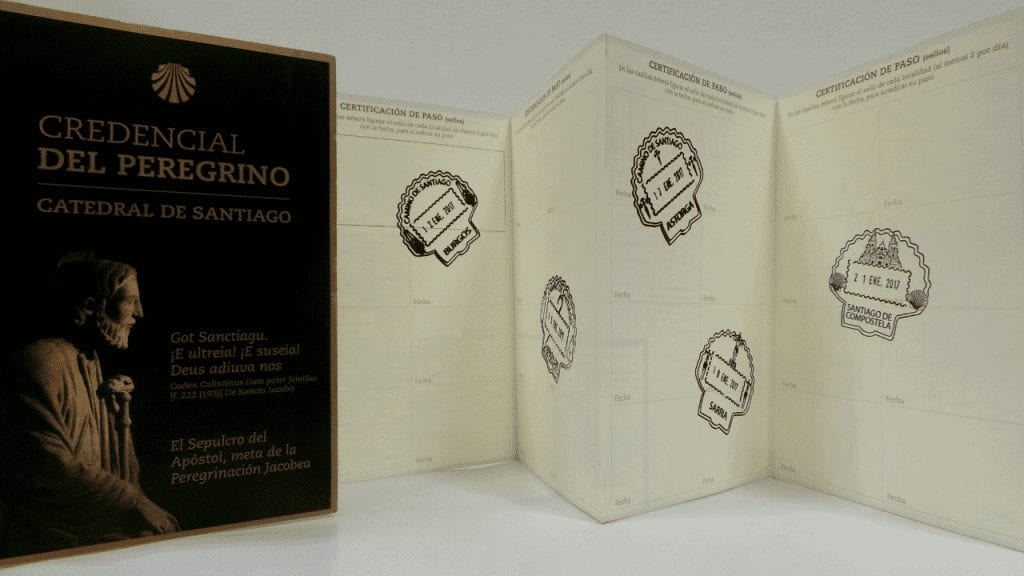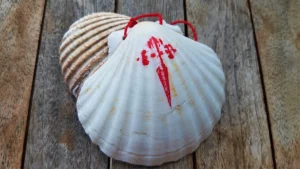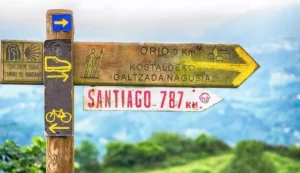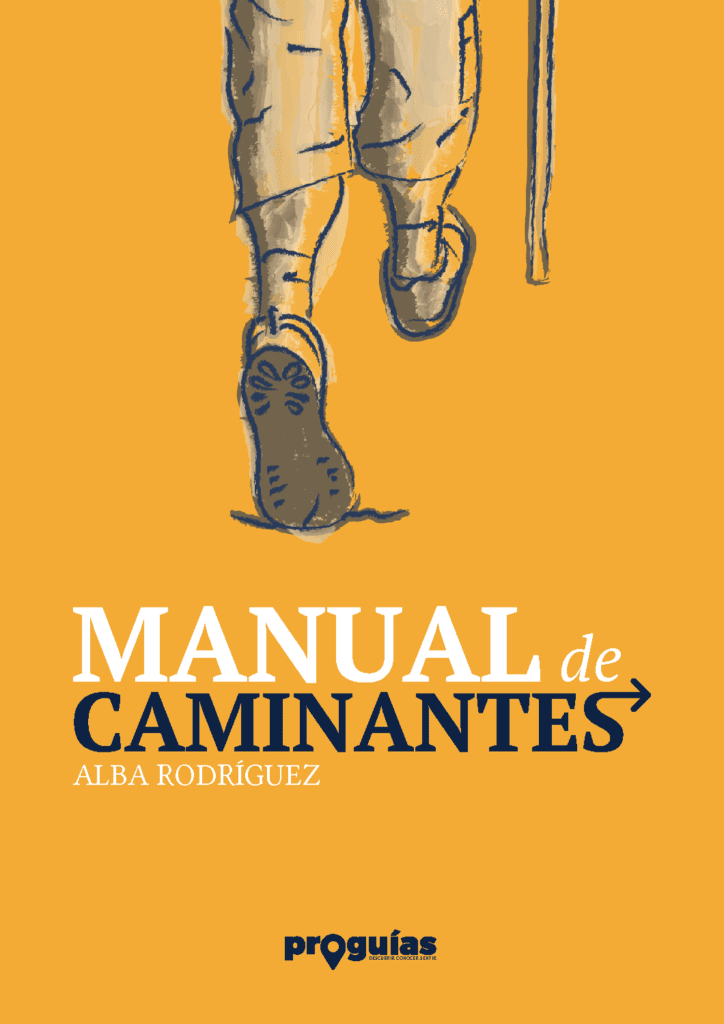The Pilgrim's Credential is one of the most important documents of the current xacobeo phenomenon. It is the document that will demonstrate our efforts as pilgrims or walkers and it is important to understand how it works to avoid misunderstandings when arriving in Santiago and requesting the Compostela or any of the alternative certificates we talk about in this other article.
Let's now look at 7 important aspects of its use and an extra tip. We leave it for you at the end.
1. What is the purpose of the Pilgrim's Credential?
If you aspire to get the Compostela (the document that proves the pilgrimage according to the rules dictated by the church) or any of the alternative certificates, the pilgrim's credential is the way to prove your pilgrimage. In other words: without a credential there is no Compostela, so keep it in a safe place and protect it as much as possible from getting wet, broken, etc.
In addition to presenting the correctly completed credential (see below for more information), the chapter of Compostela imposes other requirements that must be taken into account in order to obtain the certificate. These are:
- Having religious or spiritual motivations for walking the Way. Other motivations, such as cultural, sporting or recreational ones do not entitle you to the Compostela, and for these cases there are alternative certificates. You can see more information about this right here.
- Make the pilgrimage following one of the routes considered "official" by the archbishopric. Discover which one to choose and why.
- Do at least the last 100km on foot or on horseback, or the last 200km by bicycle. Or 100 nautical miles under sail, continuing on foot from the docking port to Compostela.
- Be aged enough to understand the religious meaning of the pilgrimage, which excludes children under 9 years of age (with exceptions, according to the archbishopric website).
- Present the Pilgrim's Credential with the necessary stamps and correctly affixed to the Pilgrim's Office staff who will issue the Compostela.
If these requirements are met, the Compostela is handed out on arrival in Santiago, at the Pilgrim's Office, at Rúa das Carretas, 33 — just three hundred metres from the cathedral.

2. How does the Credential work?
The Pilgrim's Credential is a kind of passport that accompanies us throughout the Camino. Its purpose is to collect the stamps of the pilgrimage, which you will find at different points of the Camino (below we explain where). In addition — and this is important — it is personal. This means that each person can only carry their own (or owns).
The rule says that you must put a stamp at the beginning of the stage and another at the end, so that, when you arrive at the Pilgrim's Office, the staff there will check the distances between points and that your pilgrimage is "humanly" possible. In other words: if you do the Camino on foot and between one stamp and another there are 50 or 60 km, for example, it is understood that it is not possible to do them in one day and that vehicles will have been used, so the Compostela could be denied. This is at the discretion of the Pilgrim's Office staff.
Between the first and the last stamp of each day you can place as many as you want. In fact, collecting stamps of the places you pass through has become an amusing attraction on the Camino. And no wonder. There are true wonders.
3. Where can I get my Pilgrim's Credential?
One of the questions we get asked the most is where to get the Pilgrim's Credential. If you are travelling with a specialised agency, such as Proguías, you will normally receive it along with your booking documents. But if this is not the case or you are travelling on your own, there are a number of institutions where you can find it.
First of all, there are the authorised Associations of Friends of the Camino, both in Spain as in other countries. You can also get it in some ecclesiastical institutions such as parishes and bishoprics, or in other places of worship, such as monasteries. You can check on this map (Spain / other countries) if there is a place near your home where you can get it.
Alternatively, if there is no place near your home, you can probably get it at one of the most common starting points of the Camino. For example, in Sarria you can get it at the Convent of Mercy; in Tui you will find it at the cathedral; in Roncesvalles at the Royal Collegiate Church, etc.
Handbook of Pilgrims
Download the most complete guide to prepare the Camino de Santiago from scratch and step by step.
4. A must for hostels
If you are going to do the Camino from hostel to hostel and opt for those that are public or church-run, you must bear in mind that you must present your credential to have the right to spend the night and use the rest of the services. So, once again, don't lose it!
In any case, be aware that places in hostels of this type are limited and that at peak times there may not be beds available when you arrive. Carrying your credential will not entitle you to claim a place. Places are normally allocated on a first-come, first-served basis.
Other types of accommodation such as inns, hotels, guesthouses, rural tourism houses, etc., do not require any documents. And neither do private hostels.
5. Where can it be sealed?
Along the Camino de Santiago you will find countless places with stamps you can use. All hostels have theirs, and so do most hotels, guesthouses and other accommodation of this type that you will find in the vicinity of the Camino. So it is really easy to meet the minimum requirement of stamping once at the beginning of the day and once at the end.
In the middle, as we have said, you can put as many stamps as you want. You will find them in all the temples along the way, in many public buildings, in shops, coffee-shops, etc. They come in all colours, sizes and shapes and some of them are really nice.
In any case, bear in mind that the credentials have a limited number of spaces to stamp. Their design has changed over time and the ones currently issued (2021) at the Pilgrim's Office have 34 free spaces, so, at two stamps per day, they are good for 17 days of the Camino (at least).
And we say "at least" because it is common for the Pilgrim's Office to receive credentials with stamps in the margins or on the maps that you will find on the back of the pages. The only thing that matters is that the stamps are clearly visible and date stamped. And that the distance between locations (shown on the drawing of the stamp) corresponds to the type of pilgrimage you are doing. And if you don't want to go outside the marked spaces, you always have the option of carrying another credential.
6. Not all credentials are equal
Related to the previous point, please note that not all credentials are the same. New editions are made every year and sometimes small changes are incorporated.
In addition, the Chapter has made special editions in previous years that are distributed to Friends of the Camino associations, bishoprics and parishes and may take longer to sell out. So it is possible that when you go to collect yours you will be given a credential of an older design. It doesn't matter. It is equally valid.
7. How much does it cost?
Another question we get asked a lot: how much does each credential cost? The truth is that it is difficult to indicate a universally valid price, because there are institutions that apply a small surcharge to the ones they sell.
What we can tell you is that the Pilgrim's Office in Santiago de Compostela sells them for €1.50 and that at Proguías we send one to each of the people who travel with us.
Bonus track: Take a blotting paper with you.
And finally, a quick tip. One of the unpleasant surprises of filling in our credentials on the Camino is to discover that the ink on the stamps smudges. That is, if you close the credential immediately after stamping, the still-wet ink will also stain the opposite sheet.
To avoid this, you can wait for it to dry or take a piece of blotting or other paper to place between the sheet you are stamping and its opposite. This way the excess ink is transferred to that paper and you avoid smudging the credential.






